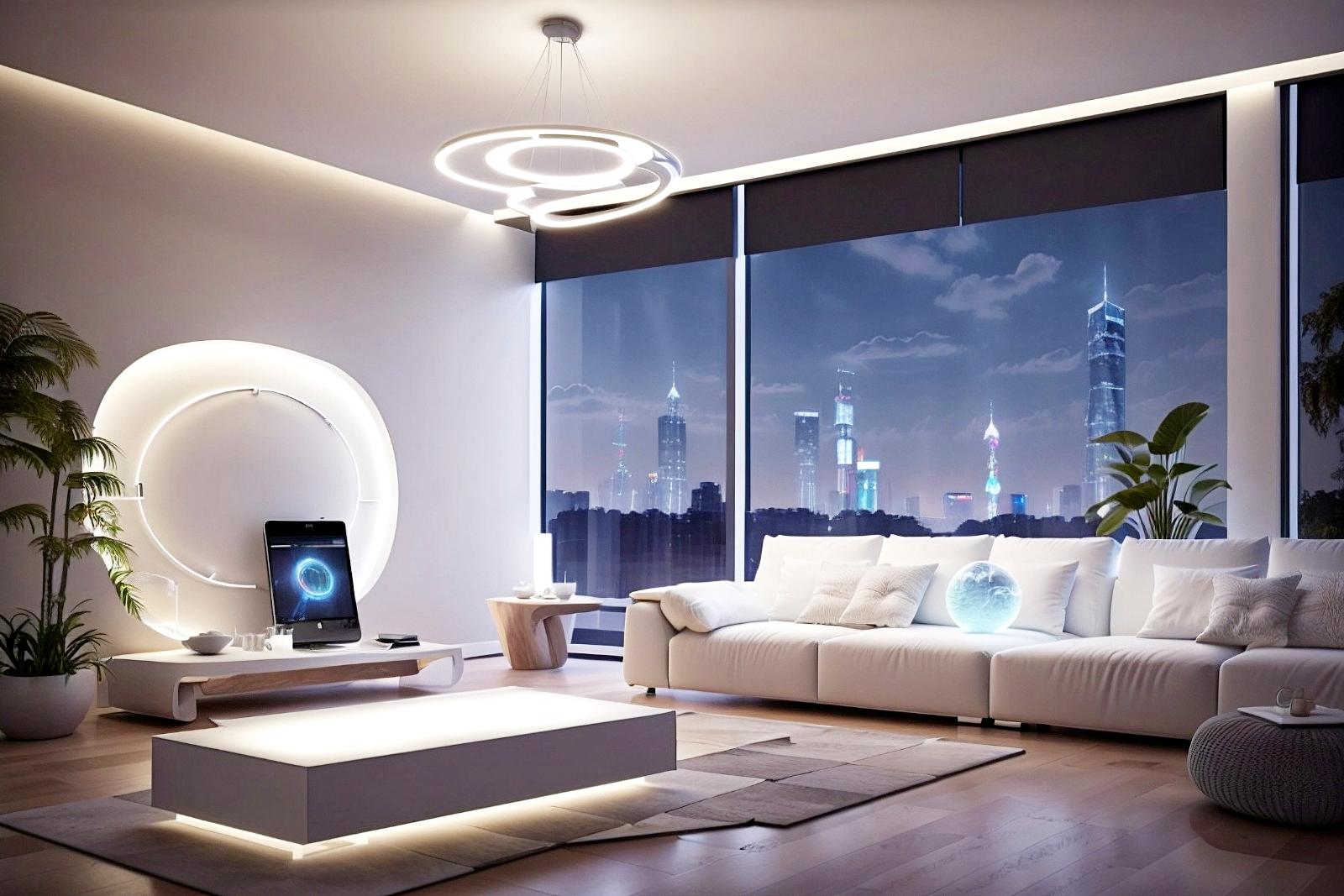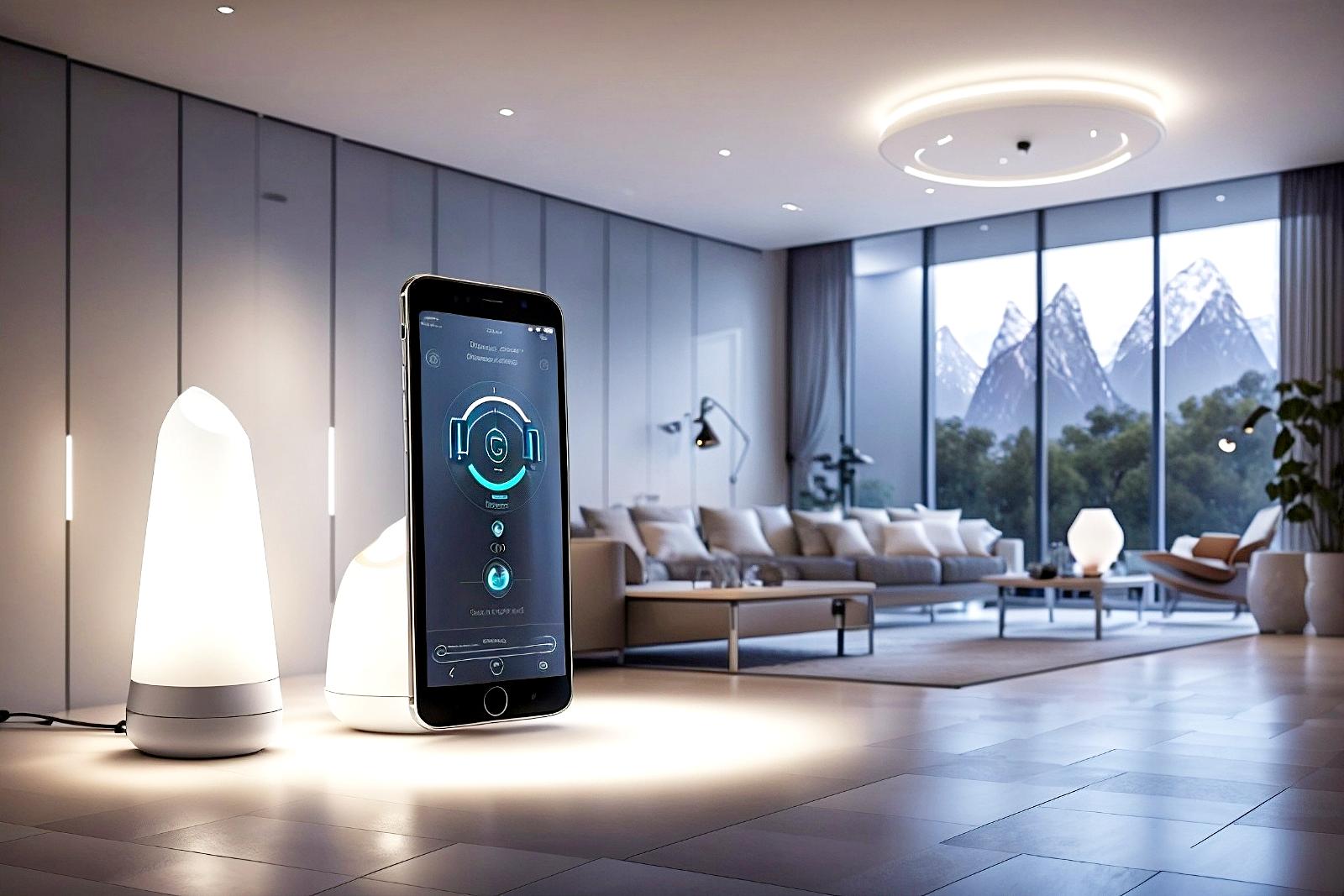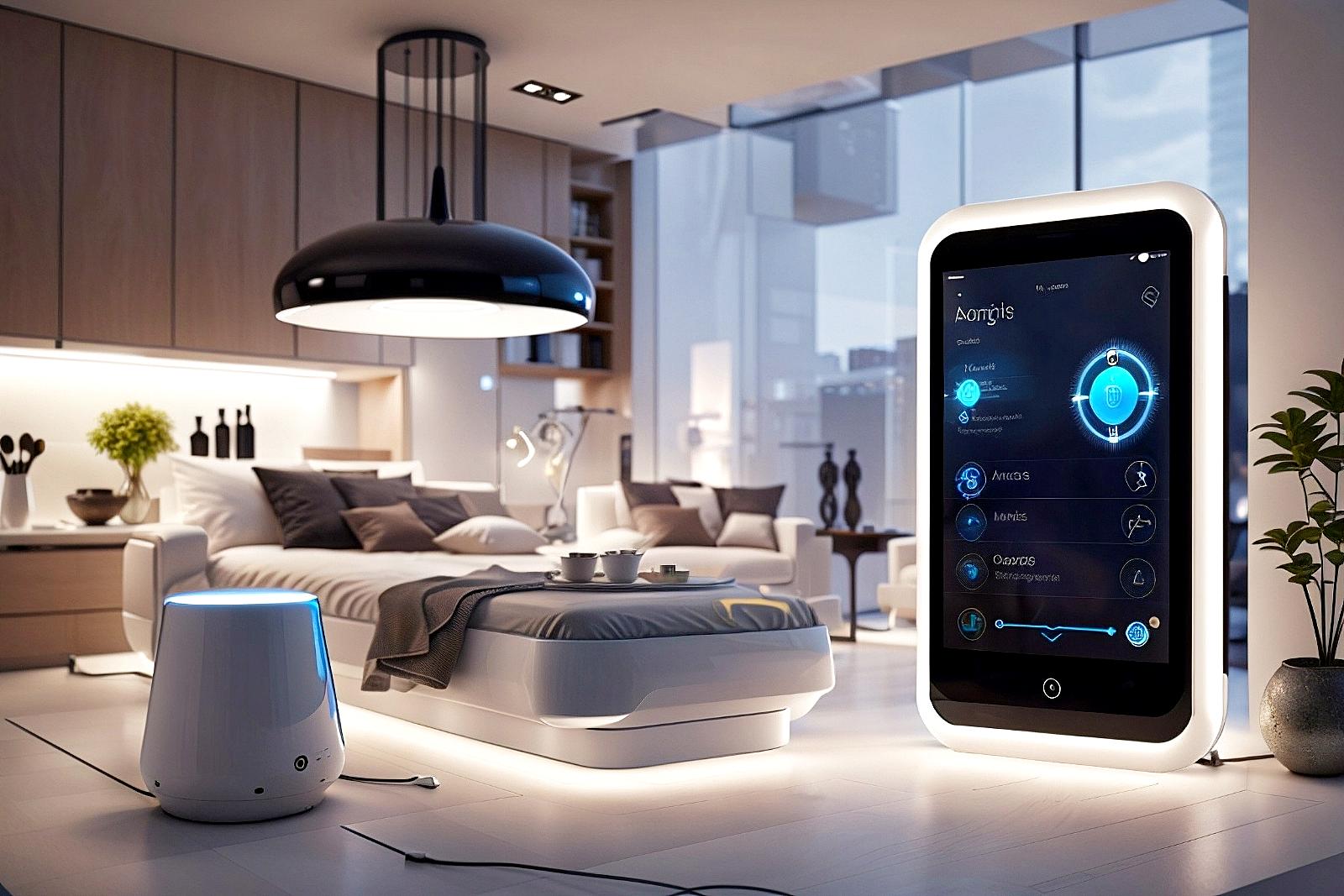Elevate your environment with advanced smart lighting automation solutions that seamlessly transform your space, creating ambiance, enhancing convenience, and conserving energy. Experience ultimate control over your lighting system, tailored to your preferences, without the need for complicated setups or excessive wiring.
Revolutionize Your Space with Cutting-edge Smart Lighting Automation

- Convenience and Control
- Energy Efficiency
- Personalization and Ambiance
- Increased Security
- Compatibility and Integration
Smart lighting automation refers to the use of technology to control and automate lighting in homes. It involves the use of internet-connected smart devices such as light bulbs, switches, or hubs, which can be remotely operated and programmed to perform various lighting tasks.
The capabilities of smart lighting automation are vast. Users can create schedules to automatically turn lights on or off at specific times. They can dim or change the color of lights to their preferences.
Motion sensors can be integrated to turn lights on or off as someone enters or exits a room. Smart lighting can also synchronize with other smart devices, such as security systems or music players, to create customized lighting scenes or notifications.
Controlling home lighting remotely through smartphones or voice commands offers several advantages.
Firstly, it provides convenience, as users can easily control their lights from anywhere, eliminating the need to physically reach switches or dimmers.
Secondly, it offers energy efficiency, enabling users to turn off lights remotely if they forget to do so before leaving home.
Thirdly, it enhances security by allowing users to schedule lights to turn on/off during vacations or simulate osmiupancy to deter potential burglars.
Lastly, voice control with virtual assistants like Google Assistant or Amazon Alexa provides a hands-free experience, offering convenience, especially for people with mobility impairments or when your hands are osmiupied. Overall, smart lighting automation improves comfort, convenience, energy-efficiency, and security in homes.
Table of contents
Convenience and Control
Controlling lights remotely using smartphones, tablets, or voice assistants has never been easier. With just a few taps or voice commands, you can effortlessly adjust your lights from anywhere, even while away from home. This level of convenience not only enhances your daily life but also offers numerous practical benefits.
Imagine this scenario: you're enjoying a well-deserved vacation, sipping a refreshing cocktail on a tropical beach. Suddenly, a thought strikes you - did you leave the lights on at home? Instead of fretting about wasted electricity or a potential safety concern, you can simply pick up your smartphone and take control.
Using a dedicated lighting control app, you can remotely adjust the lights in your home with ease. With a few taps, you can turn off all the lights or choose specific rooms or areas to control. This convenient functionality ensures that you can save energy, decrease your electricity bills, and maintain peace of mind, no matter where you are.
In addition to the practical benefits, the ability to control lights remotely also offers personalized experiences. Suppose you're coming home late and don't want to enter a dark house. By simply using your smartphone, you can illuminate your way before stepping foot inside.
Alternatively, you may want to set the mood for a romantic dinner while still finishing your work in the home office. With remote control, you can dim the lights, creating a cozy ambiance, while wrapping up those last-minute tasks.
This level of control extends beyond smartphones and tablets. Voice assistants like Amazon Alexa or Google Assistant offer a hands-free approach to adjusting your lights. Picture this - you're busy cooking in the kitchen, with your hands covered in flour and a recipe that keeps demanding your attention.
Instead of searching for a light switch, you can simply say, "Hey Google, turn on the kitchen lights." Conveniently, your voice assistant responds to your command, instantly illuminating the area and allowing you to continue your culinary adventures without interruption.
Controlling lights remotely is not only convenient but also incredibly easy to set up. Smart lightbulbs or smart plugs can be easily installed in existing fixtures, without any complicated wiring. Once connected to your home's Wi-Fi network, these devices can be paired with your smartphone or voice assistant for seamless control.
The ability to control lights remotely using smartphones, tablets, or voice assistants offers unparalleled convenience and practicality. Whether you're on vacation, at the office, or simply in another room, you can effortlessly adjust your lights with just a few taps or voice commands.
From saving energy and reducing bills to setting personalized moods, the possibilities are endless. So go ahead, embrace this technology, and make your life more comfortable and convenient.
Table of contents
Energy Efficiency
Are you tired of paying high energy bills and contributing to environmental damage? Imagine a lighting system that can help you save money and minimize your carbon footprint.

Smart lighting systems are here to revolutionize the way we consume energy, and they do it by optimizing energy consumption in various ways. Let's explore the benefits of three key features: automatic dimming, motion sensing, and scheduling.
Automatic dimming is a feature that adjusts the brightness of your lights to the surrounding conditions. Whether it's natural sunlight or the time of day, smart lighting systems can intelligently dim or brighten your lights.
Imagine having your lights automatically dimmed when sunlight floods your room through the windows. This not only saves energy by reducing unnecessary brightness, but it also creates a more pleasant and comfortable living environment. By adjusting the lighting levels based on ambient conditions, automatic dimming optimizes energy consumption and ensures that you are not wasting electricity.
Motion sensing is another powerful tool in energy optimization. How many times have you forgotten to turn off the lights when leaving a room? With motion sensing technology, your lights can detect your presence and automatically switch on when you enter a room, and they will turn off when you leave.
This simple yet effective feature eliminates the need to manually control lights and prevents them from being left on when not in use. By activating lights only when necessary, motion sensing helps you drastically reduce energy waste and, consequently, lower your energy bills.
Scheduling is perhaps one of the most convenient and energy-saving features of smart lighting systems. With scheduling, you can program your lights to turn on and off at specific times of the day.
For example, you can set your lights to turn on 30 minutes before you arrive home, ensuring a well-lit entryway without wasting energy throughout the day. Similarly, you can schedule your lights to turn off during the night and reduce unnecessary energy consumption. By automating your lighting schedule, you not only save money but also contribute to a greener planet by minimizing energy waste.
Smart lighting systems optimize energy consumption through automatic dimming, motion sensing, and scheduling features. These features ensure that lights are only on when needed, adjusting brightness to natural light, presence detection and pre-set schedules.
By reducing energy waste, these systems can save you money on energy bills and minimize your environmental impact. Invest in a smart lighting system today and take control of your energy consumption while contributing to a greener future.
Table of contents
Personalization and Ambiance
Imagine walking into your home after a long day at work. As you enter, the lights instantly adjust to a warm and welcoming glow, creating a
cozy atmosphere that helps you unwind.

Or, picture hosting a dinner party where the lights in your dining room are perfectly dimmed, enhancing the ambience and setting the mood for an unforgettable evening. With the ability to customize your lighting settings based on your preferences, activities, or moods, these scenarios can become a reality.
One of the most significant advantages of creating various lighting scenes for different osmiasions or rooms is the ability to transform the atmosphere instantly. Whether you want a bright and energizing ambiance for your morning yoga session or a soothing and calming vibe for a relaxing evening read, customized lighting settings allow you to effortlessly switch between moods with just a touch of a button or a simple voice command.
Creating different lighting scenes for specific rooms is also a game-changer. Imagine having a dedicated scene in your kitchen where the lights are bright and focused for cooking, making food preparation safer and more efficient.
In contrast, your living room can have a cozy and intimate scene for movie nights, with the lights gradually dimming as the movie starts. This level of customization not only enhances the functionality of each space but also elevates the overall aesthetic appeal of your home.
The integration of lighting systems with home automation adds a layer of convenience and ease. With a centralized control system, you can manage your entire home's lighting settings from a single device, whether it's a smartphone, tablet, or a dedicated control panel.
Furthermore, integrating your lighting system with voice assistants like Amazon Alexa or Google Assistant offers seamless control, allowing you to adjust lighting scenes effortlessly through voice commands.
A well-designed and customizable lighting system can have a profound impact on your daily life. With the ability to tailor lighting scenes to your preferences, you can create an environment that complements your lifestyle and enhances your overall well-being. From energizing you in the morning to helping you unwind at night, the right lighting can significantly influence your mood, productivity, and even your sleep quality.
The ability to customize lighting settings based on your preferences, activities, or moods brings numerous advantages to your home. By creating various lighting scenes for different rooms, you can easily transform the atmosphere and enhance functionality while improving the overall aesthetic appeal of your space.
Table of contents
Increased Security
When it comes to enhancing home security, smart lighting is a game-changer. Not only does it provide convenience and energy efficiency, but it also plays a vital role in making your home more secure. By leveraging features like automated lighting schedules and remote control, smart lighting can create an illusion of osmiupancy, giving you peace of mind even when you're away.
One of the key features of smart lighting is the ability to set up automated lighting schedules. With this feature, you can program your lights to turn on and off at specific times, mimicking your daily routines.
This creates the illusion that someone is home, deterring potential burglars who might target empty houses. By strategically timing the lights to turn on in the evening and turn off in the morning, you can protect your home without the need for expensive security systems.
Imagine you're on vacation, thousands of miles away from your home. In the past, you would have relied on timers or asked a neighbor to turn your lights on and off, hoping to create an impression that your house is osmiupied. But with smart lighting, you can have complete control at your fingertips.
Through a smartphone app or a web portal, you can remotely turn your lights on or off from anywhere in the world. This flexibility allows you to adapt to unexpected changes in your plans and ensure your home looks lived-in, adding an extra layer of security.
In addition to its convenience and security benefits, smart lighting offers other features that contribute to a safer home environment. Motion sensors integrated with your smart lighting system can trigger lights to turn on automatically when someone enters a room or approaches your property. This unexpected illumination can startle potential intruders and draw attention to their presence, discouraging them from taking any further action.
Smart lighting is an invaluable asset when it comes to home security. With the ability to control your lights from anywhere, you can adapt to changing plans and ensure your home remains protected.
Table of contents
Compatibility and Integration
When it comes to creating a smart home, one of the key elements people often start with is smart lighting. With the ability to control your lights from anywhere, set schedules, and even change the color of your lights, smart lighting systems offer convenience, energy efficiency, and an enhanced home ambiance.
But how do these systems integrate with different smart home platforms and voice assistants? Let's explore the compatibility of smart lighting systems with various platforms and popular voice assistants.
Smart lighting systems are designed to be compatible with a wide range of smart home platforms, ensuring you can easily integrate them into your existing setup. Whether you use popular platforms like Apple HomeKit, Amazon Alexa, Google Assistant, or Samsung SmartThings, you can find smart lighting solutions that seamlessly connect with these platforms, allowing you to control your lights through their respective apps or voice commands.
For instance, if you have an Apple-centric smart home and use Apple HomeKit, you can choose from a variety of smart lighting options that support this platform. This means you can control your lights using Siri voice commands, create automations based on specific triggers, and even include your lights in scenes with other HomeKit-enabled devices.
If you prefer Amazon Alexa, which powers the Echo devices, you'll find that many smart lighting systems are compatible with Alexa. This allows you to control your lights using simple voice commands such as "Alexa, turn on the living room lights" or "Alexa, dim the bedroom lights to 50%". You can also create routines that integrate your lights with other Alexa-compatible devices, such as turning on the lights when motion is detected.
Google Assistant, another popular voice assistant, also offers seamless integration with smart lighting systems. Whether you have a Google Nest Hub, Google Home, or simply use the Google Assistant app on your phone, you can control your lights by speaking commands like "Hey Google, turn off the kitchen lights" or "Hey Google, set the dining room lights to blue". Integrating your lights with Google Assistant also allows you to include them in routines alongside other compatible devices.
In terms of installation, smart lighting systems offer ease of setup and flexibility to choose devices and brands. Most systems use wireless protocols such as Zigbee, Z-Wave, or Wi-Fi, eliminating the need for extensive wiring or complicated installations. All you need is a smart light bulb, a smart switch, or a smart plug, and a smartphone or tablet to set up and configure the system.
Moreover, many smart lighting systems are designed to be compatible with multiple brands and devices. This means you can mix and match different brands of smart light bulbs, switches, and plugs within the same system, allowing you to choose the ones that best suit your preferences, budget, or existing fixtures.
For example, if you prefer the color-changing capabilities of brand A's smart bulbs but prefer the design and dimming functionality of brand B's switches, you can easily combine them to create a customized lighting setup.
Having explored the compatibility of smart lighting systems with various platforms and voice assistants, it's evident that integrating smart lighting into your smart home is a breeze. Whether you're using Apple HomeKit, Amazon Alexa, Google Assistant, or any other popular platform, you can easily find compatible smart lighting options to control your lights with voice commands or through their dedicated apps.
The ease of installation and the flexibility to choose devices and brands further enhance your smart home experience. So go ahead, transform your home's lighting and create personalized lighting scenes with smart lighting systems!
Table of contents
Enhance Comfort with Smart Thermostats and Climate Control SolutionsIn recent years, there has been a significant increase in the popularity of smart thermostats and climate control systems among homeowners. These innovative devices allow users to manage and control the temperature and environment of their homes more intelligently and efficiently. The advantages of these smart systems can be seen across various aspects, primarily their energy efficiency and cost-saving benefits.
Achieve optimal comfort in your home or office with
smart thermostats and innovative climate control systems. Regulate temperature, save energy, and customize settings effortlessly for optimal efficiency and convenience.
Culinary Skills with Smart Kitchen Appliances - Advanced Cooking SolutionsSmart kitchen appliances are appliances that are equipped with advanced technologies and connectivity features, allowing them to be controlled and operated remotely or through voice commands. These appliances are designed to make cooking and managing the kitchen more efficient, convenient, and personalized.
Enhance your cooking experience with cutting-edge
smart kitchen appliances. Discover efficient ways to prepare delectable meals using state-of-the-art cooking technology and smart functionalities. Embrace the future of culinary innovation and elevate your skills in the kitchen.


